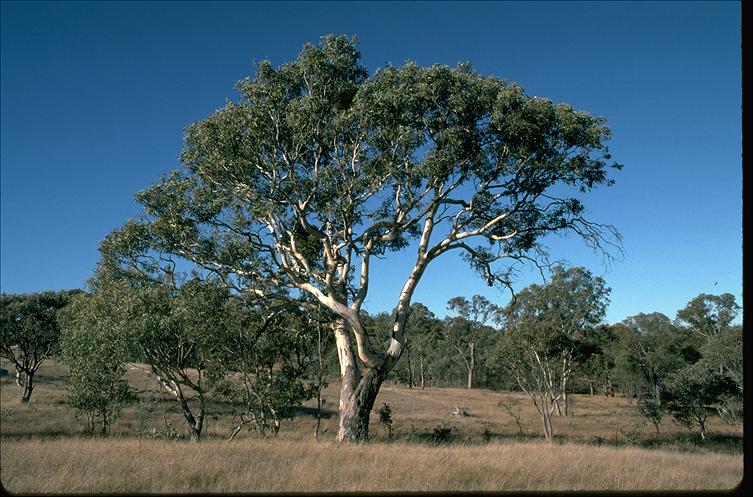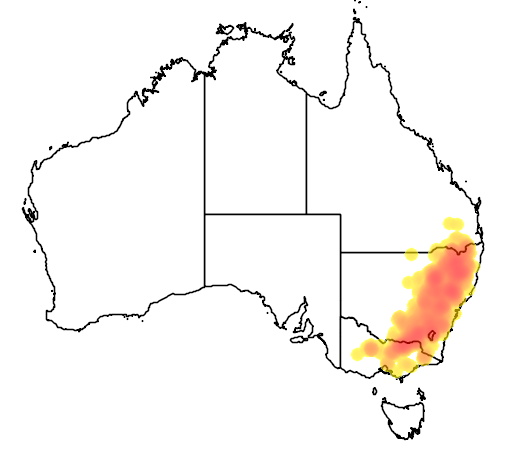Description
Common names
Blakely"s Red Gum, Blakely"s Red-gum, Blakely"s Redgum, Blakelys Gum, Blakelys Red Gum, Forest Red Gum, White Budded Red Gum, White-budded Red-gum.
Scientific names
Eucalyptus blakelyi.
Family
Myrtaceae.
Genus
Eucalyptus.
Name origin
Blakelyi, after W.F. Blakely (1875-1941), author of A Key to the Eucalypt, 1934.
Rainfall
450mm.
Growth rate
Moderate.
Growth height
Up to 20m.
Presence in Australia
Widespread, in most catchments and districts on the drier hills and slopes.
This specie has been identified in the following Australian states: Qld, NSW, ACT, Vic.
Habitat
Grassy woodlands on various soils. Commonly moderately fertile soils.
Habit
Tree to 20m high with smooth, patchy white bark with grey to brown or red patches, shedding in large plates or flakes. Dull green or grey-green leaves.
Similar species
Distinguished from Tumbledown Gum (E. dealbata) and Dwyer"s Gum (E. dwyeri) by fruit and form. It has more or less raised fruit disc whereas Tumbledown Gum and Dwyer"s Gum have flat or sunken discs. Distinguished from River Red Gum (E. camaldulensis) by buds, which are cone-shaped, and not beak-shaped, as on River Red Gum. Refer to Practical Information Note - The Red Gum Story.
Site preference
Compact loams, below 800m elevation. Tolerates frost, winter waterlogging and drought.
Characteristics
Hardy. Moderate growth rate. Prone to damage by psyllids ("lerps") in some areas, thought to be due to an imbalanced environment, lacking in understorey and predatory birds. Refer to Practical Information Note - The Red Gum Story. Hybridises with Tumbledown Gum, Dwyer"s Gum and River Red Gum.
Flowering
Usually white, mainly summer, but also late spring (generally just prior River Red Gum flowering). Heavy flowering may occur every 2-3 years, depending on season.
Seed collection
Early Feb to late May, and possibly throughout year. Monitoring required as seeds shed after maturity.
Propagation
From seed (±687 viable seeds per gram). 25-300C is optimum germination temperature.
Regeneration
From seed, during favourable season such as wet summers, particularly in absence of competitive exotic grasses. Recovers well after fire.
Shade and shelter
Useful medium-level cover in windbreaks if interspersed with understorey and other eucalypts to reduce pysllid activity. Provides protection from fire as is relatively slow-burning, has high water content with low quantities of oils or resins, high salt level in leaves, and smooth bark.
Land protection
Useful in gully erosion control, behind more fibrous-rooted understorey plants.
Fuel
Burns well.
Timber
Similar to other Red Gums. Used for fence posts, sleepers, garden edges and in furniture. Hard, red, strong and reasonably durable timber. Density about 980 kg/m3. Uniform texture and interlocked grain.
Wildlife
Good habitat. Flowers food for nectar-feeding birds and many insects, at a critical breeding time for many species. Insect-eating birds attracted. Hollows are nesting and refuge sites for many birds such as parrots, the Australian Owlet-nightjar, mammals such as Antichinus species, and reptiles such as goannas. Foliage-gleaning and scale-feeding birds attracted.
Ornamental
Attractive for parks and gardens, probably best interplanted with local native understorey shrubs and other trees to minimise damage from leaf psyllids or "lerps".
Other
Leaves produce dyes ranging in colour depending on mordants used.


